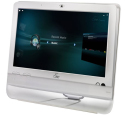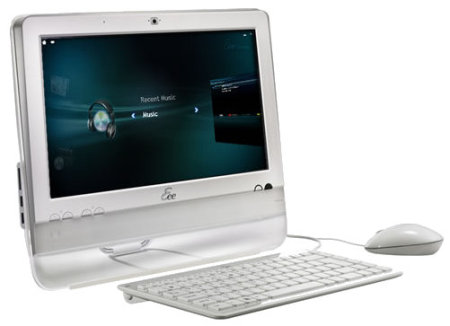Touch-enabled net-top boots Linux fast
Oct 15, 2008 — by LinuxDevices Staff — from the LinuxDevices Archive — 2 views In November, Asus will ship a $400 Windows-based “nettop” that includes an integrated touchscreen and Linux-based “Express Gate” quick boot technology. The “Eee Top” reportedly has a 15-inch display, 1.6GHz Intel Atom processor, 1GB of RAM, a 160GB hard drive, and a gigabit Ethernet port.
In November, Asus will ship a $400 Windows-based “nettop” that includes an integrated touchscreen and Linux-based “Express Gate” quick boot technology. The “Eee Top” reportedly has a 15-inch display, 1.6GHz Intel Atom processor, 1GB of RAM, a 160GB hard drive, and a gigabit Ethernet port.
(Click here for a larger view of the Eee Top)
While Asus hasn't formally announced the Eee Top, the device has popped up on the websites of two U.K. resellers. There was no word about a Linux version, but the Windows XP Home based device displayed on the two sites is said to offer Asus's Express Gate technology, a stripped-down Linux environment stored in Flash ROM. A version of DeviceVM's Splashtop technology, Express Gate reportedly allows users who are in a hurry to bypass Windows, loading the Firefox web browser, Adobe Flash, Skype, and a photo viewer “within a few seconds.”
Similar Linux-based fast-boot environments are increasingly popping up on Windows computers. Some, like the new Dell Latitude models that include a “Latitude ON” technology, even run Linux on a separate low-powered smartphone processor, to save battery life.
The Eee Top is listed in white, with the model number ETP1602-WT, or black, with the model number ETP1602-BK. Both feature a compact wired keyboard and mouse, and seem to “float” in the air thanks to their transparent lower bezels.

The Asus Eee Top has stereo speakers and “floats” on a transparent bezel
(Click to enlarge)
The EEE Top has a 15-inch touchscreen display, whose resolution is not specified. Below the screen are stereo speakers, said to be driven by 4 Watts of amplification per channel. Apart from this, the rest of the system's ingredients are par for the “nettop” course. Like Shuffle's recent X27, for example, the device includes Intel's 1.6GHz Atom 230 processor, plus the supporting 82945GC northbridge and 82801GB (ICH7) southbridge.
The EEE Top also offers 1GB of RAM, up to 128MB of which can be used as graphics memory. For mass storage, there's a 160GB hard drive, and the device also has a memory card reader that accepts Memory Stick and SD media.
Asus' all-in-one apparently lacks an optical disk drive, but one could of course be added via one of the computer's four USB ports. The device includes both an 802.11b/g wireless LAN adapter and a gigabit Ethernet port, and it also sports a 1.3 megapixel camera, according to resellers.
While the EEE Top's touchscreen display is the device's only distinctive hardware ingredient, the supplied software adds more interest. The device offers the touchscreen-enabled “EEE Cinema” software (seen in the above photos), which visually resembles Microsoft's Windows Media Center.
Features and specifications listed for Asus' EEE Box by resellers Clove Technology and Play.com include the following:
- Processor — Intel Atom 230 clocked at 1.6GHz
- Memory — 1GB of DDR2 RAM
- Storage — 160GB hard disk drive
- Display — 15.6 inch touchscreen display, with unspecified resolution
- Networking:
- LAN — Gigabit Ethernet port
- WLAN — 802.11b/g wireless networking
- LAN — Gigabit Ethernet port
- Other I/O:
- 4 x USB 2.0
- Audio:
- 1 x mic in
- 1 x line in
- 1 x line out
- 1 x mic in
- 4 x USB 2.0
- Expansion — Memory card reader (supports SD/SDHC/Memory Stick/Memory Stick Pro)
- Dimensions — n/s
- Power requirements — 65W AC adapter with 19VDC output
- Weight — 9.47 pounds (4.3kg)
More information may be found on the Play.com website, here, and Clove Technology website, here.
This article was originally published on LinuxDevices.com and has been donated to the open source community by QuinStreet Inc. Please visit LinuxToday.com for up-to-date news and articles about Linux and open source.